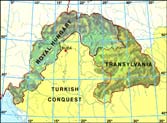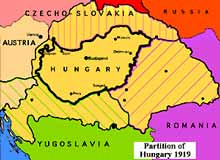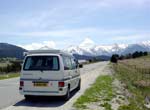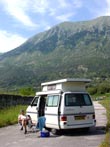|
|
Rhapsody from Hungary - PROLOGUE |
||
|
Why Hungary?
The question is bound to be asked. Last August we stood close to the
Slovenian/Hungarian border, looking eastwards; what's over beyond, we
wondered. Well this year we plan to find out. There is so much to learn about
Magyar culture and civilization, with its torrid and turbulent history. Science
and Music: Hungarians
have figured prominently in the sciences (though not while in their native
Hungary), including Nobel Prize-winner, Albert Szent-Györgyi
for his pioneering work on Vitamin C, and physicists Ede Teller and Leo
Szilárd who worked on the development of the atomic bomb.
Similarly, music owes much to Hungarian 19th and 20th century composers and
musicians: Ferenc (Germanised as Franz) Litz (1811-86) whose Hungarian
Rhapsodies reflect traditional Gypsy music of his native country;
Ferenc Erkel (1810-1893), composer of Hungary's national anthem and Bánk
Bán a tragic opera based on work by fellow Hungarian dramatist József Katona;
Béla Bartók (1881-1945) and Zoltán Kodály (1882-1967) whose works again are based on Hungarian traditional
music. Webs to be published during the course of our trip will include
accompanying music by these Hungarian composers. Strauss was of course
Austrian but since at that time, Hungary was part of the Habsburg
Empire and the Danube is such a prominent part of the Hungarian landscape,
this week's music has crept in. The Republic of Hungary since 1989: what the Hungarians call az átkos 40 év (the accursed 40 years) of Communist rule came to a peaceful end with Hungary's first multiparty free elections of October 1989 when the former Socialist Workers' Party, restyled the Hungarian Socialist Party, won a parliamentary majority. The new state of the Republic of Hungary was proclaimed and the last Soviet troops departed in June 1991. Despite several changes in government during the 1990s, the transition to market economy has proceeded, albeit more slowly than many had hoped, curbing inflation, lowering interest rates and attracting foreign investment. In April 2002, the largest turnout of voters in Hungarian history returned a coalition government of Socialists and Free Democrats under Prime Minister Péter Medgyessy, a free market advocate. But after disagreements with coalition partners, he was succeeded as Prime Minister by Ferenc Gyurcsány in September 2004. Most importantly for the country's future development, Hungary became a fully fledged member state of the EEC in April 2004. Hungarian character: with such a history of being the 'fall guys' of Europe, it is not surprising that the Hungarian character seems archetypally pessimistic. Hungary used to top the world rankings in suicide rates, reflecting the Magyar adage of sírva vigadás - 'tearful merrymaking'. Last year we met a Hungarian in Prekmurje (an area ceded to Slovenia in 1920, then Yugoslavia) who spoke bitterly of Trianon as if it had only happened yesterday. No wonder that 'Trianon' remains the most reviled word in Hungary: many of the problems created remain and still colour Hungary's relations with its neighbour states. Hungarian Language: and what about the Language? It's as enigmatic as the people, belonging to the Finno-Ugric linguistic group, distantly related to Finnish and Estonian, though its origins remain a total mystery. It's a non-Indo-European language, totally unrelated to the Romance, Germanic or Slavic languages, incredibly complex in syntactical structure and pronunciation. We have our work cut out with this one! One final factor if you are thinking of visiting Hungary (or indeed any of the other East European states) and planning on outdoor activities such as camping or walking: you need to be aware of the potentially serious health risk of tick-born encephalitis which is endemic in these areas. For more details, go to the Tick-Alert web site www.masta.org/tickalert/ It is best to protect yourself by inoculation: visit the Masta web site given on the Web sites for Travellers links page elsewhere on this site, for the nearest Masta clinic. That's the background. These are our plans. You can see our intended route across across the Continent via Vienna by clicking on the maps above. As usual we'll be publishing regular fortnightly updates with news and pictures of our travels. Add the site to your Favourites and keep watching. Sheila and Paul Published: Wednesday 3 August 2005
|



 accelerated
as corruption and incompetence bankrupted the treasury, leaving the country
open to invasion by the Ottoman Turks whose empire spread northwards into
Europe from the Balkans under Sultan Suleiman the Magnificent. The fateful
Battle of Mohács in 1526 was a catastrophic defeat for the Magyars, and
opened the way to Vienna for the muslim Turks potentially to overrun western Europe.
To forestall this, Habsburg Austria took control of northern Royal
Hungary, while the Turks installed a puppet regime in Transylvania. With
the eventual expulsion of the Turks after 150 years of oppressive
occupation, rule of Hungary in effect passed to Habsburg Austria. Despite
several Magyar attempts at nationalistic revolution against Austrian rule
during the 19th century, and increased prosperity under the Dual Monarchy
of the Austro-Hungarian Empire, Hungary's
accelerated
as corruption and incompetence bankrupted the treasury, leaving the country
open to invasion by the Ottoman Turks whose empire spread northwards into
Europe from the Balkans under Sultan Suleiman the Magnificent. The fateful
Battle of Mohács in 1526 was a catastrophic defeat for the Magyars, and
opened the way to Vienna for the muslim Turks potentially to overrun western Europe.
To forestall this, Habsburg Austria took control of northern Royal
Hungary, while the Turks installed a puppet regime in Transylvania. With
the eventual expulsion of the Turks after 150 years of oppressive
occupation, rule of Hungary in effect passed to Habsburg Austria. Despite
several Magyar attempts at nationalistic revolution against Austrian rule
during the 19th century, and increased prosperity under the Dual Monarchy
of the Austro-Hungarian Empire, Hungary's future was inextricably tied to the fate of the
Empire. Diplomatic treaties with imperial Germany dragged the
Austro-Hungarians into World War I with
disastrous consequences for Hungary. In the aftermath of
WW I, the victorious Allies imposed their punitive solution of dissolving the
Habsburg Empire in favour of the 'Successor States', Romania,
Czechoslovakia and Yugoslavia, who would acquire much of their new
territory at Hungary's expense. Under the 1920 Treaty of Trianon, Hungary
lost 72% of its former territories, 3 million (60%) of its citizens, 58%
of its rail network, 43% of arable land, 83% of its iron ore resources and
its only port, Rijeka. Henceforth Hungary was landlocked despite being
ruled during the 1920s and 30s by an Admiral, the right wing Miklós
Horthy.
Resentment against the punitive Trianon diktat inclined Hungary towards
nazi Germany, and the country joined the fascist Axis in 1941. Despite regaining some
of the lost territories early in WW II, Hungary was occupied by German
forces in 1944 who, along with Hungarian fascists, deported 400,000
Hungarian Jews to concentration camps. By the time the Red Army took
Budapest in April 1945, the city was in ruins with every Danube bridge
destroyed. Under Soviet control, Hungary now was ruled by a Communist
regime backed by the brutally oppressive secret police, the AVO. An
attempted uprising against the Communists in 1956 was ruthlessly crushed
by Soviet tanks while the West was distracted by the Suez crisis. The
initially oppressive rule of Moscow-backed János Kádár gradually moved towards a more
relaxed form of market-oriented 'goulash socialism' during the 1970s and
80s,
future was inextricably tied to the fate of the
Empire. Diplomatic treaties with imperial Germany dragged the
Austro-Hungarians into World War I with
disastrous consequences for Hungary. In the aftermath of
WW I, the victorious Allies imposed their punitive solution of dissolving the
Habsburg Empire in favour of the 'Successor States', Romania,
Czechoslovakia and Yugoslavia, who would acquire much of their new
territory at Hungary's expense. Under the 1920 Treaty of Trianon, Hungary
lost 72% of its former territories, 3 million (60%) of its citizens, 58%
of its rail network, 43% of arable land, 83% of its iron ore resources and
its only port, Rijeka. Henceforth Hungary was landlocked despite being
ruled during the 1920s and 30s by an Admiral, the right wing Miklós
Horthy.
Resentment against the punitive Trianon diktat inclined Hungary towards
nazi Germany, and the country joined the fascist Axis in 1941. Despite regaining some
of the lost territories early in WW II, Hungary was occupied by German
forces in 1944 who, along with Hungarian fascists, deported 400,000
Hungarian Jews to concentration camps. By the time the Red Army took
Budapest in April 1945, the city was in ruins with every Danube bridge
destroyed. Under Soviet control, Hungary now was ruled by a Communist
regime backed by the brutally oppressive secret police, the AVO. An
attempted uprising against the Communists in 1956 was ruthlessly crushed
by Soviet tanks while the West was distracted by the Suez crisis. The
initially oppressive rule of Moscow-backed János Kádár gradually moved towards a more
relaxed form of market-oriented 'goulash socialism' during the 1970s and
80s,
